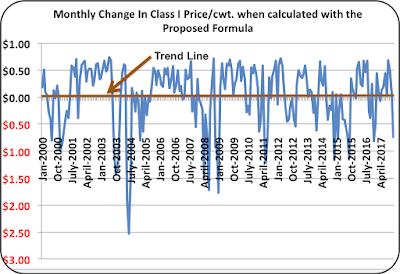The stated reason for the change was that when the price of Class I milk was based on the Class III price or the Class IV price, those companies that were attempting to hedge pricing had to pick one or the other well ahead of time. Any such decision one way or the other could stand a chance of being right or being wrong.
With the new formula, using both the Class III and Class IV prices equally in the formula, they could always hedge on both Class III and IV and be covered. Over the long term, the Class III has been higher than the Class IV and the analysts calculated that an additional $.74 was needed to make the payment equivalent over the long term.
______________________________________
The "before" and "after" formulas are shown below:
BEFORE MAY 1, 2019
Base Skim Milk Price for Class I = Higher of Advanced Class III or Advanced Class IV Skim Milk Pricing Factors
EFFECTIVE MAY 1. 2019
Base Skim Milk Price for Class I = ((Advanced Class III Skim Milk Pricing Factor + Advanced Class IV Skim Milk Pricing Factor) / 2) + $0.74
________________________________________
In the last month of 2019, the new formula produced a result not experienced in the last 10 years.
Over the eight months that the new formula was in effect, the Class I price was $.12 per cwt. higher by the new formula than the old formula. That was a win for milk producers. However, in the last month of 2019, the Class I price was $1.40 per cwt. lower by the new formula.
 |
| Chart I - Class I Milk Price May to December of 2019 |
 |
| Chart II - Class I Milk Price Differential May to December of 2019 |
It has been over 10 years since the spread between the two formulas has exceeded a negative $1.40 per cwt. and it has happened only five times in the 20-year history of the current pricing system.
 |
| Chart III - Monthly Changes in the Class I Milk Price with new Pricing Formulas |
Borrowing a political phrase, "What difference does it make?" In a word, the difference is "de-pooling." De-pooling has become a standard process and is now a part of the science of milk pricing. Members of an FMMO can de-pool Class II, III, and IV milk if it is financially advantageous. It becomes advantageous when your Class of milk is worth more than the Uniform (average) price of the four Classes. If that is the case, milk can be de-pooled, with limitations, and not be in the pricing pool and receive a negotiated price which should be higher than the pool price.
What makes the Class III milk price lower than the Uniform price? The FMMO structure is built around the concept that the volume and pricing of Class I milk will keep the Uniform price higher than the Class III price. In December of 2019, the new formula calculation for Base Skim Class I milk was $11.61 per cwt., while the Skim Class III price was $12.11. As a result, the Uniform price in most Federal Orders was lower than the Class III price. With that, much of the Class III milk was de-pooled.
Tracking de-pooled milk accurately is impossible but by most estimates, significant de-pooling occurred in December 2019. As some milk de-pools from a Federal Order with a higher price, there is less money available for others who remain in the pool.


No comments:
Post a Comment